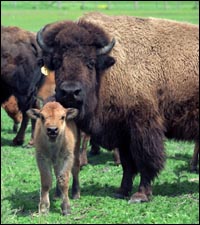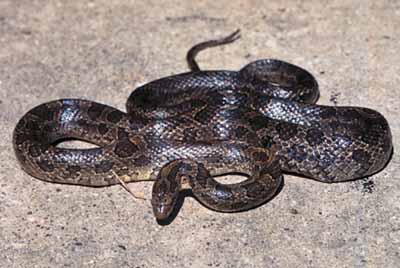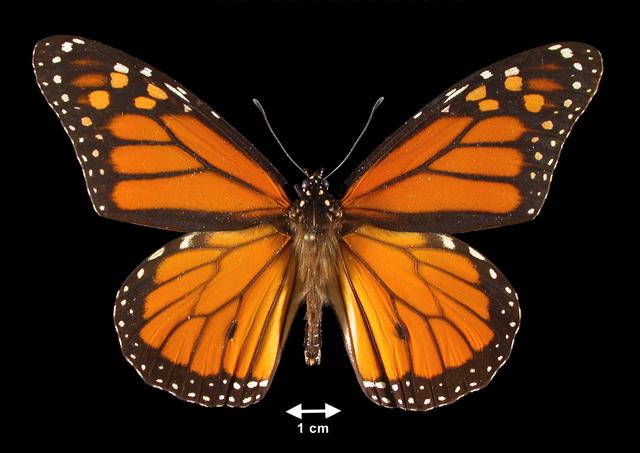Changing Prairie: Prairie Animals
Before the coming of the pioneers, the prairies of Illinois provided habitats for hundreds of species of animals. Some of the large mammals, such as the bison and elk, disappeared in the early nineteenth century, but we can still find many of these mammals, birds, reptiles, and insects today.
Mammals:

Copyright Fermilab
The American Bison (Bison bison) was found throughout the prairie in the early 1700s, but decreased sharply in the late 1700s because of severe winters and heavy hunting with rifles. Native Americans hunted the bison for food and clothing. It was probably extirpated from Illinois by 1830. It grazed on prairie grasses, traveling in herds between summer and winter ranges, which were sometimes a distance of 400 miles apart.
The bulls may weigh up to 3,000 pounds. The smaller land slimmer cows weigh up to 900 pounds. Bison are capable of running at a top speed of 35 miles per hour. Their average life span is about 25 years. Cows usually give birth to a single calf in May.
Franklin's ground squirrel (Spermophilus franklinii) occurs in the tall grass prairie regions of Illinois. It lives in well-drained burrows, where it hibernates in winter. It is omnivorous, feeding on a variety of plants and carrion (dead animals), other small mammal material, insects, bird eggs, and ground-dwelling birds. Four to eleven young are born in the fall.
Learn about more Prairie mammals in the Museum's Prairie in Illinois Web
module's mammal
section
and in Prairies
in the Prairie State site.
Birds:
Dickcissel (Spiza americana) is a common migrant and summer resident in grasslands. It feeds mostly on seeds. The female lays three to five blue eggs in a bulky crude nest on the ground or up to two meters high in weeds or small trees in mid-May to early August.

Courtesy of the Missouri Department of Conservation
Greater Prairie Chicken (Tympanuchus cupido) was once common in prairie regions, but now is managed heavily on preserves and listed as an endangered species. The reduction of populations was due to loss of habitat, hunting pressure, and competition with ring-necked pheasant, an introduced species.
Prairie Chickens forage on the ground for insects, especially grasshoppers. They also eat a variety of plant material, including leaves, buds, seeds, and acorns. Females lay seven to seventeen eggs in a nest on the ground among grasses and weeds.
The scientific name refers to the Prairie chicken's mating habit of "booming"
by filling their air sacs as they perform their mating ritual.
Learn more about this at DNR
Brown-headed cowbird (Molothrus ater) got its common name from its habit of following the bison heard on the short-grass prairies and eating the insects stirred up by the bisons' hooves. When European settlers opened up more land to short crops, the cowbirds came into this habitat. This also exposed other species of birds to the cowbirds "brood parasitism" - its habit of laying eggs (about seven, one at a time) in the nests of other species of birds, not building their own nests.
The cowbird is a common migrant and summer resident in grasslands with low, scattered trees. It feeds on seeds and insects.
American goldfinch (Carduelis tristis) is a common summer and winter resident and migrant, found in a variety of habitats. It feeds mostly on seeds, but feeds its young mostly insects. The female lays five to six eggs in a nest lined with thistle down in weedy shrubby areas, usually in a small tree.
Learn about more prairie birds.
Reptiles:

Photograph courtesy of Dr. Everett Cashatt
Prairie Kingsnake (Lampropeltis calligaster) is common in prairie areas of the southern two-thirds of Illinois. It feeds mostly on small mammals, such as moles, voles, and shrews, but also eats other snakes, amphibians, birds, and insects. The female lays seven to twenty eggs in mid-summer, which hatch in August and September.
Learn about other prairie reptiles.
Invertebrates (Insects and spiders):
Black and yellow argiope spider (Argiope aurantia) constructs its large orb web in fields, marshy places, and meadows. It is found throughout the United States. The mature adults trap and feed on mostly grasshoppers. On the web can often be found an egg sac the size of a hickory nut. It is constructed in the fall. Eggs hatch in the spring.
American grasshopper (Schistocerca Americana) occurs in a variety
of habitats in the southern and Midwestern United States. It feeds on a wide
variety of plants. The female lays clusters of 60 to 80 eggs in the spring
and again in the fall. This species is one of only a few grasshoppers that
overwinter as an adult.
Handsome locust (Syrbula admirabilis) occurs in grasslands and
wet meadows of Illinois. It feeds mostly on prairie grasses, especially big
bluestem. Eggs are laid in the soil in the fall to hatch in the late spring.

Photograph by Dr. Everett Cashatt, Illinois State Museum
Monarch butterfly (Danaus plexippus) is a common butterfly in open areas throughout Illinois. Its caterpillar feeds on milkweed (Asclepias sp) species, some of which contain a poison that is absorbed by the caterpillar and that makes the adult unpalatable to prey. Monarchs migrate as far south as Mexico to overwinter. Females lay eggs on the way north in the spring.
Learn about other prairie
invertebrates and
prairie
animals at the Museum's Prairie Web module.






